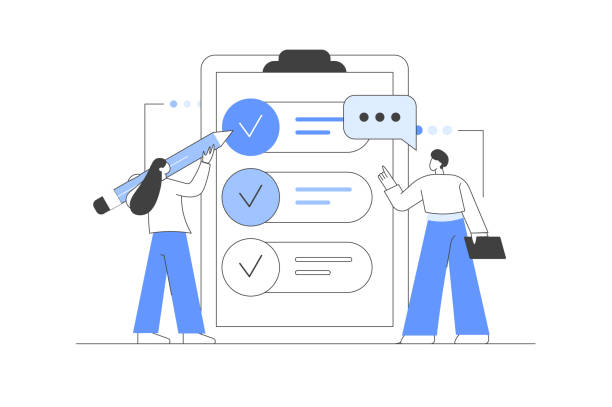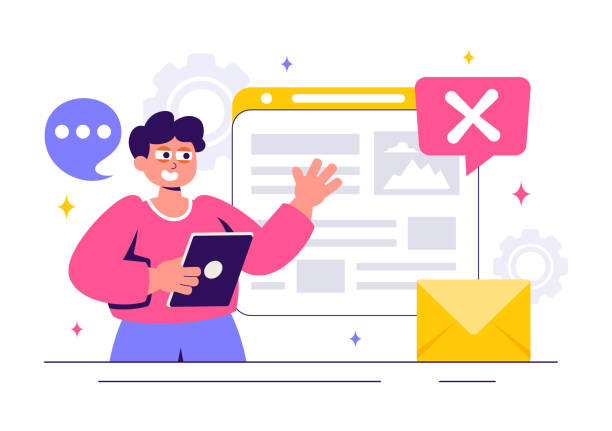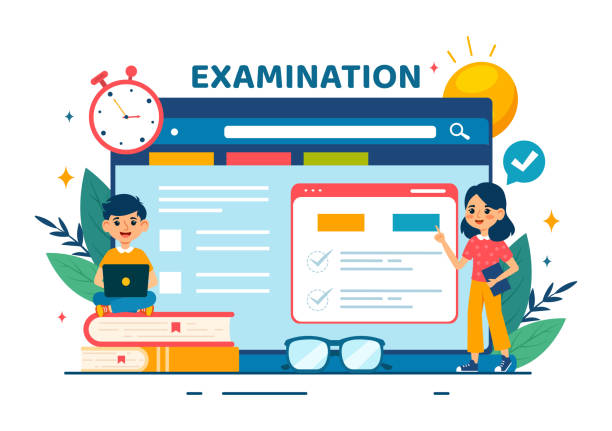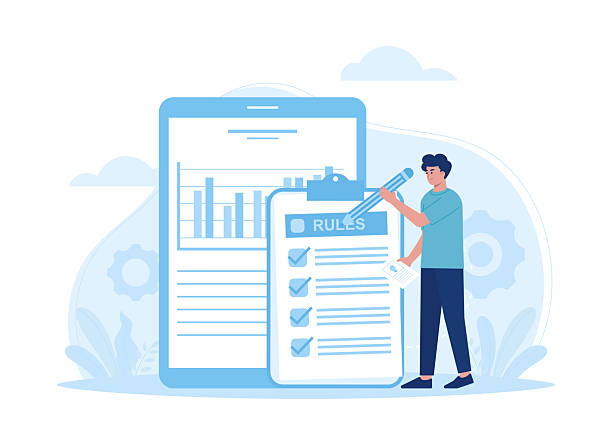Introduction to SEO-Optimized Website Design

In today’s digital world, simply having a website is just the first step.
What truly matters is its visibility among a multitude of competitors.
This is precisely where the concept of #SEO_optimized_website_design, or website optimization for search engines, comes into play.
This approach isn’t merely about adding a few keywords to the text; rather, it encompasses a comprehensive strategy for building a website that is efficient and appealing to both users and search engine bots like Google.
The main goal of SEO-optimized website design is to improve the site’s ranking in organic search results, which in turn leads to increased traffic, brand awareness, and ultimately, business growth.
A properly SEO-optimized website acts like a signboard in a big city; without it, potential customers might never find your business.
This process begins from the very initial stages of design and includes selecting the right structure, optimal loading speed, smooth user experience, and creating valuable content.
Therefore, any business seeking sustainable online success must place SEO at the core of their website design.
This is a long-term investment that brings significant returns in the form of increased online visibility and credibility.
Did you know that 94% of users’ first impressions of a business are related to its website design? With professional corporate website design by **Rasawweb**, turn this first impression into an opportunity for growth.
✅ Attract more customers and increase sales
✅ Build credibility and trust in the eyes of the audience⚡ Get a free website design consultation!
Core SEO Principles in Web Design

To achieve an #optimized_website that ranks at the top of search results, adhering to core #SEO principles during the web design phase is essential.
These principles fall into two main categories: #On-Page_SEO and #Technical_SEO.
In the on-page SEO section, optimizing elements visible to both the user and the search engine, such as Title Tags, Meta Descriptions, friendly URL structure, and proper use of Heading tags (H1, H2, H3), is of great importance.
Each page should have a unique and appealing title that incorporates its main keyword.
Meta descriptions, while not directly impacting rankings, play a crucial role in encouraging users to click on your link in search results.
Alongside these, technical SEO addresses aspects not directly seen by the user but vital for #crawling and #indexing the website by search engines.
Elements like the robots.txt file, which tells search engines which parts of the site to crawl and which to ignore, and the XML sitemap (sitemap.xml), which clarifies the site’s page structure for engines, are highly important.
Site loading speed, mobile-friendliness, and the use of the secure HTTPS protocol are also among the critical technical SEO factors.
The stronger your website is technically, the easier it will be for search engines to understand your content and display it to users.
SEO-optimized website design means that all these principles are integrated into the site development process from the outset to prevent complex issues from arising in the future.
Information Architecture and User Experience in SEO

One of the main pillars of #SEO_optimized_website_design is the optimization of information architecture and user experience (UX).
These two concepts are not only related but also have significant overlap with SEO.
A strong information architecture helps search engines better understand the structure and importance of different pages on your website, while a positive user experience keeps users on your site longer and reduces the bounce rate.
These signals are considered by search engines as indicators of your content’s quality and value, helping to improve your ranking.
Site structure includes how content is organized and how users access it.
Using clear and logical navigation, defined hierarchical paths, and smart #internal_linking can distribute SEO power (Link Juice) throughout the site and lend authority to deeper pages as well.
For example, a strong homepage should link to main category pages, and these pages, in turn, to specific product or article pages.
Furthermore, good user experience goes beyond mere aesthetic appeal.
It includes ease of use, fast loading speed, and accessibility on various devices.
Pages that are difficult to navigate, have long loading times, or do not display correctly on mobile devices not only drive users away but also decrease your SEO ranking.
SEO-optimized website design, by focusing on these aspects, means creating a platform that is both understandable for search engines and enjoyable for humans.
| Element | Description | SEO Importance |
|---|---|---|
| Hierarchical Structure | Organizing content from general to specific (Homepage > Category > Subcategory > Product/Article). | Helps search engines understand the relationship between pages and distribute authority. |
| Clear Navigation | User-friendly menus, breadcrumbs, and efficient internal search. | Improves user experience and easier crawling by bots. |
| Internal Linking | Linking related pages to each other within the site. | Transfers page authority, increases user dwell time, and aids crawling. |
| Friendly URLs | Short, meaningful web addresses containing keywords. | Better readability for users and search engines. |
Valuable Content: The Backbone of SEO

In any #SEO strategy, content is king, and this principle particularly holds true in #SEO_optimized_website_design.
Without high-quality and relevant content, even the best technical and aesthetic site structure cannot bring you to top search results.
Search engines, especially Google, are increasingly focusing on valuable, in-depth, and unique content that fully meets users’ informational needs.
This means that simply repeating keywords (Keyword Stuffing) is no longer enough; instead, you must produce content that genuinely answers audience questions, solves their problems, and provides information not easily found elsewhere.
Keyword Research is the first step in producing SEO-driven content.
This process helps you identify the phrases your target audience uses to search.
But merely finding keywords is not enough; you must also understand the User Intent behind those words.
Is the user looking for information (informational search), wanting to buy something (transactional search), or looking for a specific website (navigational search)? Your content must match this intent.
Furthermore, the concept of E-E-A-T (Experience, Expertise, Authoritativeness, Trustworthiness), introduced by Google, plays a vital role in content quality.
Content written by experienced experts with strong scientific or experiential backing holds more value from the perspective of both search engines and users.
SEO-optimized website design also involves planning for regular content updates and continuously adding new content to keep your site dynamic and relevant.
Video content, infographics, and optimized images can also contribute to the appeal and ranking of your content.
Are you tired of your e-commerce site getting visitors but no sales? Rasawweb solves your main problem with professional e-commerce website design!
✅ Significant increase in sales with targeted design
✅ Flawless user experience for your customers
⚡ Get a free consultation!
Site Speed and Responsiveness: A Key Role in SEO

In the current era, where user attention to online speed and efficiency has increased more than ever, #site_loading_speed and #responsiveness (compatibility with different devices) have become two critical factors in #SEO_optimized_website_design.
Google has repeatedly emphasized that these factors not only directly impact user experience but are also important ranking elements in search algorithms.
A website that loads slowly not only dissatisfies users and increases the Bounce Rate but also may be visited less by search engine bots, leading to fewer pages being indexed.
The concept of Core Web Vitals, introduced by Google, is a set of real user metrics for measuring user experience, including LCP (Largest Contentful Paint – time to load largest content), FID (First Input Delay – time to respond to first user interaction), and CLS (Cumulative Layout Shift – visual layout stability).
Optimizing these metrics is essential for any #successful_website_design.
Reducing image sizes, compressing CSS and JavaScript files, using a CDN (Content Delivery Network), and choosing high-quality hosting are among the effective methods for increasing site speed.
In addition to speed, #responsive_design is also of paramount importance.
Given that a significant portion of searches today are performed via mobile devices, Google has adopted a #Mobile-First_Indexing policy; meaning, for ranking, it primarily examines the mobile version of your site.
A website that does not display correctly on mobile will not only create a bad user experience but also will not achieve a good ranking in search results.
Therefore, SEO-optimized website design means ensuring an excellent user experience on any device and at any internet speed.
Essential Tools for Website Design and Optimization
![]()
Success in #SEO_optimized_website_design and its maintenance is almost impossible without the right tools.
These tools help you monitor your site’s performance, find suitable keywords, identify and fix technical issues, and analyze your competitors.
Knowing and properly utilizing these tools is crucial for any webmaster seeking to continuously improve their site’s ranking.
At the top of the list are free Google tools that are essential for any website:
- Google Search Console: This tool allows you to view your site’s performance in Google search results.
You can check crawl errors, indexing issues, keywords users used to find your site, and incoming backlinks.
For every #SEO_website_designer, this tool is a goldmine of information. - Google Analytics: Provides you with deep insights into user behavior on your site.
You can see where users came from, what pages they visited, how long they stayed on the site, and where they left.
This information is highly valuable for optimizing user experience and content. - Google PageSpeed Insights: This tool analyzes your site’s loading speed on desktop and mobile and offers suggestions for improvement.
As mentioned earlier, site speed is an important SEO factor.
In addition to these, keyword research tools like Google Keyword Planner (free), Ahrefs and SEMrush (paid) help you find suitable keywords for your content and evaluate their competitiveness.
Backlink analysis tools and rank monitoring tools are also useful for tracking progress and analyzing competitors.
SEO-optimized website design is an ongoing process, and these tools will be your powerful arm on this path.
Challenges and Common Mistakes in SEO-Optimized Design

On the path of #SEO_optimized_website_design and its optimization, there are common challenges and mistakes that can render your efforts fruitless.
Awareness of these issues and avoiding them is key to success in search engine rankings.
One of the biggest mistakes is #Keyword_Stuffing.
This outdated and obsolete tactic, where keywords are used unnaturally and repeatedly in the text, not only ruins user experience but is also identified as spam by search engines and leads to site penalties.
Instead, keywords should be used naturally and in meaningful contexts.
Another common mistake is neglecting site loading speed and lack of mobile optimization.
In this era, where most users connect to the internet via mobile, a site that doesn’t display well on mobile or is slow is doomed to fail.
Also, #Thin_Content or Duplicate Content are other serious problems.
Low-value or copied content cannot meet user needs and is considered low-value by search engines.
Ensuring the originality and value of content is vital for any SEO-optimized website design.
Technical issues such as #Broken_Links and #crawl_errors can also harm a site’s SEO.
Broken links disrupt user experience and also cause problems for search bots in indexing the site.
Moreover, improper use of XML sitemap and robots.txt file can lead to search engines not finding important pages on your site, or conversely, indexing private pages.
Preventing these common mistakes requires continuous monitoring and updating knowledge in the field of SEO.
| Common Mistake | Impact on SEO | Solution |
|---|---|---|
| Keyword Stuffing | Google penalties, poor user experience. | Natural and semantic use of keywords. |
| Low Loading Speed | Increased bounce rate, lower search rankings. | Image optimization, code compression, CDN usage. |
| Lack of Mobile Responsiveness | Penalty in mobile-first indexing, poor user experience. | Responsive Design. |
| Low-Value or Duplicate Content | Reduced site authority, poor ranking. | Produce original, comprehensive, and valuable content. |
| Broken Links or Crawl Errors | Poor user experience, indexing issues. | Regular checks with Google Search Console, link correction. |
Case Study: Success of SEO-Optimized Website Design

To better understand the impact of #SEO_optimized_website_design, examining a hypothetical case of success can be very insightful.
Assume a small business selling handmade products (e.g., jewelry) has just started its operations.
Initially, their website is beautiful but receives no organic traffic and is not visible in search results.
After some time, by adopting a comprehensive #SEO_marketing strategy and making fundamental changes to their website design, astonishing results are achieved.
The first step was in-depth keyword research.
Keywords like “handmade women’s jewelry”, “buy traditional silver earrings” and “unique gemstone necklaces” were identified.
Then, the site’s information architecture was revamped so that users and search engines could easily find products by type, material, and style.
Category and product pages were created with optimized titles and meta descriptions.
Next, rich and user-friendly content was written for each product and category.
This content included the story behind each product, raw materials, manufacturing process, and high-quality images.
A blog was also launched, publishing articles on “Guide to Choosing the Right Jewelry” and “Tips for Caring for Handmade Jewelry”.
All this content was optimized naturally using targeted keywords.
Technically, site speed was optimized, and the site became fully mobile-responsive.
With the passage of a few months, the results were visible.
The site’s ranking for targeted keywords steadily increased, monthly organic traffic grew by over 300%, and this increase in traffic directly led to a 150% increase in online sales.
This hypothetical example demonstrates how SEO-optimized website design not only increases website visibility but also positively impacts the business’s bottom line, turning it into a powerful tool for sustainable growth.
Don’t have a corporate website yet and missing out on online opportunities? With professional corporate website design by Rasawweb,
✅ Double your business credibility
✅ Attract new customers
⚡ Free consultation for your corporate website!
The Future of SEO-Optimized Website Design and Emerging Trends

The world of #SEO is constantly evolving, and every year we witness emerging trends and changes in search engine algorithms.
#SEO_optimized_website_design will increasingly revolve around the user and their experience in the future.
One of the most important trends that should be focused on now and in the near future is Voice Search.
With the increasing use of voice assistants like Siri, Google Assistant, and Alexa, people are asking their questions verbally instead of typing.
This means that websites need to be optimized for longer, more natural phrases (Long-Tail Keywords), which resemble everyday conversations.
The role of #Artificial_Intelligence (AI) in SEO is also growing.
Google’s algorithms like RankBrain and BERT use AI to better understand user intent and content meaning.
This means a greater focus on content quality and depth, rather than just keywords.
Content that is truly comprehensive and addresses complex user needs will continue to succeed in the future.
Also, visual and video content will gain more importance.
Optimizing images and videos for search, including adding appropriate Alt Text and descriptions, is essential for the future of SEO-optimized website design.
Beyond keywords, a precise understanding of users’ #Search_Intent will become even more crucial.
Search engines aim to provide the most accurate and relevant answers to user queries, even if the exact words the user used are not in your content.
Therefore, focusing on providing comprehensive solutions and answers to user needs, regardless of rigid and old formulas, will be the main guide for SEO-optimized website design in the coming years.
The future of SEO belongs to sites that, alongside technological advancements, adhere to the fundamental principles of providing value to the user.
How to Start SEO-Optimized Website Design for Your Business?

Starting the #SEO_optimized_website_design process for your business might seem complex at first, but with a systematic approach, it is manageable.
The first step is to conduct a #comprehensive_audit of your current website’s status (if you already have one) or initial research to understand the market and competitors (if you plan to design a new site).
This analysis includes examining the site’s structure, speed, content, backlinks, and potential technical issues.
The goal is to identify current strengths and weaknesses.
After the analysis comes the #planning phase.
In this stage, you identify your target keywords based on market research and high-volume keywords related to your business.
Then, you develop a content strategy that specifies what type of content (articles, product pages, videos, etc.) you will produce, with what keywords, and for what purpose.
Additionally, the site structure and its technical roadmap are designed at this stage to ensure the website is optimized for crawling and indexing by search engines from the very beginning.
The #implementation phase involves building or rebuilding the website based on the principles of SEO-optimized website design.
This includes clean coding, image optimization, SSL certificate implementation, logical URL structure, and site speed optimization.
Throughout the content creation process, ensure that the content is both high-quality and optimized for target keywords.
Finally, continuous monitoring and optimization are of paramount importance.
SEO is not a one-time process; use tools like Google Search Console and Google Analytics to monitor your site’s performance, track algorithm changes, and improve your site based on data.
This continuous approach will help you stay ahead in the competitive online space.
Frequently Asked Questions
| Question | Answer |
|---|---|
| What is SEO-Optimized Website Design? | Designing a website that is optimized for both users and search engines to achieve higher rankings. This includes adhering to technical, content, and user experience principles. |
| Why is SEO important in website design? | The importance of SEO in website design is due to its role in increasing site visibility in search results, attracting organic traffic, improving user experience, and enhancing user credibility and trust. |
| What are the most important elements of SEO-friendly website design? | Mobile responsiveness, high loading speed, clear navigation structure, proper use of heading tags (H1-H6), image optimization, and quality content. |
| What is the impact of responsiveness (mobile-friendliness) on SEO? | Google uses mobile-first indexing, meaning it prioritizes the mobile version of websites for ranking. Therefore, responsiveness is crucial for SEO. |
| What is the role of site speed in SEO? | Faster websites provide a better user experience, reduce bounce rate, and are favored by search engines. Site speed is one of Google’s ranking factors. |
| How to optimize images for SEO? | By compressing image sizes, using descriptive and relevant file names, and most importantly, writing appropriate Alt Text relevant to the content and keywords. |
| What is the importance of content in SEO-driven design? | High-quality, relevant, and keyword-rich content is crucial for attracting and engaging users, as well as for ranking in search engines. Content is the king of SEO. |
| How does URL structure affect SEO? | Clean, descriptive, short URLs containing keywords help users and search engines better understand the page’s content and appear in search results. |
| What is Schema Markup and what is its role in SEO? | Schema Markup is structured data that helps search engines better understand website content and display it as Rich Snippets in search results, which increases the click-through rate (CTR). |
| Should SEO be considered from the beginning of website design? | Yes, it is highly recommended. Integrating SEO principles from the initial phase of website design saves time and cost, and leads to better and more sustainable long-term results. |
And other services of Rasawweb Advertising Agency in the field of advertising
Smart Marketing Automation: A fast and efficient solution for increasing sales with a focus on attractive UI design.
Smart Direct Marketing: A novel service for increasing online growth through marketing automation.
Smart Link Building: Professional optimization for campaign management using attractive UI design.
Smart UI/UX: A combination of creativity and technology for analyzing customer behavior through precise audience targeting.
Smart Advertorial: A professional solution for increasing click-through rates with a focus on attractive UI design.
And over a hundred other services in the field of internet advertising, advertising consultation, and organizational solutions.
Internet Advertising | Advertising Strategy | Advertorial
Resources
What is SEO-Optimized Website Design?
The Importance of SEO in Business Success
Comprehensive SEO Guide for Beginners
The Impact of Web Design on Site SEO
? Transform your business in the digital world with Rasawweb Afarin. By providing comprehensive digital marketing services, including custom website design, we help you shine in today’s competitive market and achieve your goals.
📍 Tehran, Mirdamad Street, next to Bank Markazi, Kazeroon Jonubi Alley, Ramin Alley, No. 6

